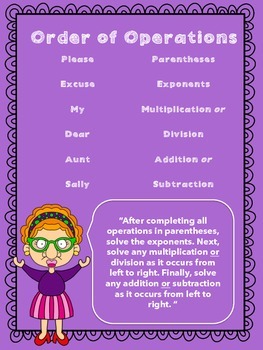

Example: (12 4) + 6 x 2 1 = x 2 1 = none, so skip this operation My Dear: = Aunt Sally: 14 = Answer: 14 Reproducible 1 Please Excuse My Dear Aunt Sally All activity guides can be found online:Ģ Reproducible 2 S o l ve the following equations in the correct ord e r. Students should follow this order each time they solve a problem with multiple operations, simply omitting the steps that do not apply to the equation they are solving. Be sure to explain to students that not all problems will include every operation. In this example, the pink arrows mark the addition step ( = 338), while the orange arrow denotes the subtraction (338 3 = 335). Aunt Sally demonstrates that addition and subtraction should be computed during the final step of the process and, similar to My Dear, they should be calculated in the order (left to right) in which they appear. The darker purple arrows illustrate that multiplication is being computed (64 x 5 = 320), while the lighter purple arrows show that division is occurring (6 2 = 3). This acronym does not imply that multiplication should always be done before division. Stress that multiplication and division are part of the same step, and they should be computed in the order (left to right) in which they appear.

Next, tell students that the My Dear words of the acronym indicate that multiplication and/or division are included in the next step of the process. Mention that the blue arrow indicates that we are now computing 4 3, which equals 64. Explain to students that if exponents are included, they are always computed next in the process.

Point to the second word of the acronym, Excuse = Exponents. Draw students attention to the green section of the poster, and explain how the green arrows indicate that the operations inside the parentheses are being completed (2 x 9 = 18 and 16 4 = 4). Explain to students that if a problem contains parentheses, the operations inside them are always done first. Point to the first word of the acronym, Please = Parentheses. By repeating the acronym several times throughout your lesson, you will help students to remember it. Point to the acronym at the top of the poster and tell students that this is a common way to remember the order of operations. Included in this Really Good Stuff set you ll find: Order of Operations Poster, 19" x 24" This Really Good Stuff Activity Guide Introducing the Order of Operations Poster Display the poster in an area that is visible to your students. Range operator, which produces one reference to all the cells between two references, including the two references.1 Really Good Stuff Activity Guide Order of Operations Poster Congratulations on your purchase of the Really Good Stuff Order of Operations Poster a colorful reference poster to help your students remember the order of operations as they solve math problems. Where A1 holds "Last name" and B1 holds "First name", =A1&", "&B1 results in "Last name, First name".Ĭombine ranges of cells for calculations with the following operators. Use the ampersand ( &) to concatenate (join) one or more text strings to produce a single piece of text.Ĭonnects, or concatenates, two values to produce one continuous text value When two values are compared by using these operators, the result is a logical value-either TRUE or FALSE. You can compare two values with the following operators. To perform basic mathematical operations, such as addition, subtraction, multiplication, or division combine numbers and produce numeric results, use the following arithmetic operators. There are four different types of calculation operators: arithmetic, comparison, text concatenation, and reference. Using parentheses allows you to change that calculation order. Excel follows general mathematical rules for calculations, which is Parentheses, Exponents, Multiplication and Division, and Addition and Subtraction, or the acronym PEMDAS (Please Excuse My Dear Aunt Sally). Operators specify the type of calculation that you want to perform on the elements of a formula. Excel for Microsoft 365 Excel 2021 Excel 2019 Excel 2016 Excel 2013 Excel 2010 Excel 2007 More.


 0 kommentar(er)
0 kommentar(er)
